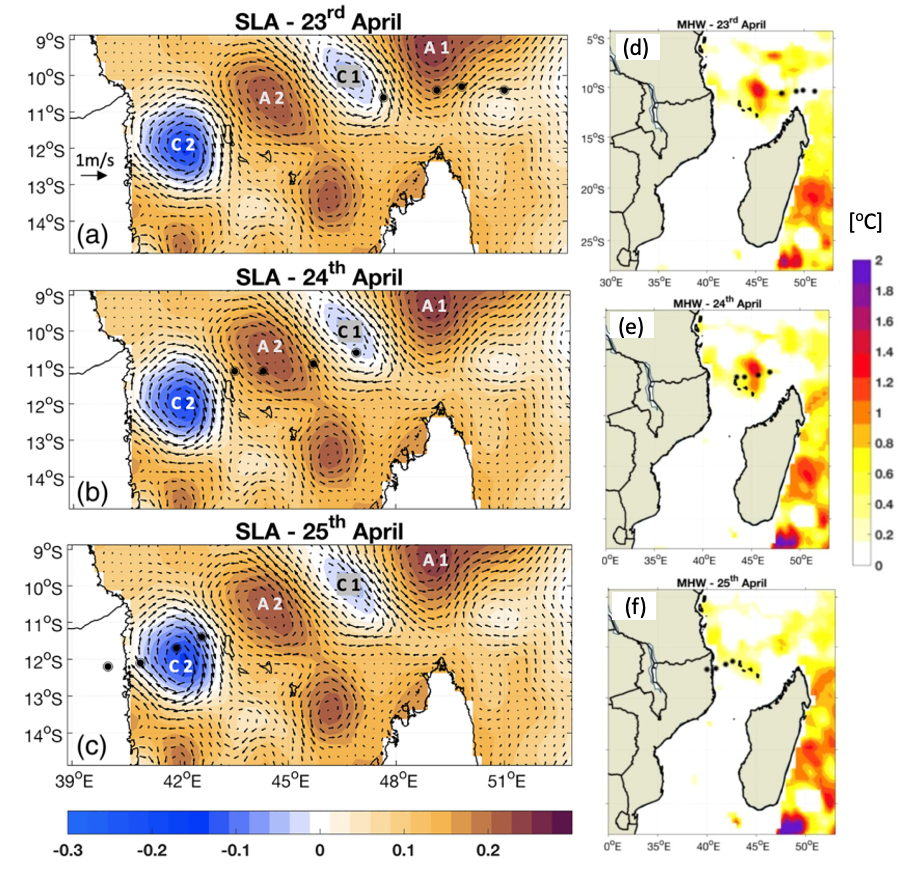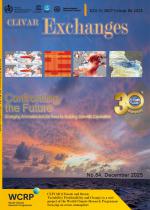Advection-driven marine heatwaves and co-occurring extremes in the Mozambique Channel

Figure 1: (a-c) Spatial map of AVISO sea level anomalies (SLA) overlaid with geostrophic velocities during the lifespan of tropical cyclone Kenneth on 23-25 April 2019 (Mawren et al., 2020). (d-f) Spatial distribution of marine heatwave mean intensity between 23-25 April 2019. Black circles represent the 6-hourly position of TC Kenneth at 0, 6, 12 and 18:00 UTC on each day.
Marine heatwaves (MHWs) are events characterized by prolonged and extremely warm ocean conditions, and have been detected in recent decades over many regions of the global ocean, including the Mozambique Channel located offshore of southeastern Africa. The Mozambique Channel is known as one of the source regions of the greater Agulhas current system. Small variations in ocean temperature in the Channel can have a strong influence on the weather and climate of the African subcontinent and can also harm marine ecosystems and communities connected. Despite it being known that the broader Indian Ocean basin is warming, little to no work on marine heatwaves has been done in this region. Some recent studies led by D. Mawren and with the contribution from J. Hermes, co-chair of the Indian Ocean Region Panel (IORP), provide an improved understanding of the important role of horizontal advection, associated with anticyclonic eddies on the evolution of MHWs, as well as the co-occurring extremes in the Mozambique Channel.
A study published in the journal of Climate Dynamics (Mawren et al, 2022a) shows that in austral summer 2017, an area off the southwest coast of Madagascar experienced the most persistent and intense MHW intensity (~3.5 oC above climatology) on record. Although extreme warming was triggered by anomalous net surface heat fluxes driven by wind relaxation and increased insolation, the peak in temperature was associated with the presence of an anticyclonic eddy. However, Mawren and co-authors implied that the persistence of this event in the southern Channel was attributed to remote influences from large-scale climate variability, i.e., strong positive subtropical Indian Ocean Dipole (SIOD) and westward extending Mascarene high.
While persistent MHWs can lead to widespread ecological implications, they can also cause indirect impacts on coastal livelihoods especially when they co-occur with other extreme weather events. A recent study by Mawren and co-authors in the special “Coastal Hazards in Africa” issue of the Estuarine, Coastal and Shelf Science journal (Mawren et al., 2022b), showed a few cases where MHWs acted as a preconditioning factor for fuelling convective systems such as tropical cyclones (TCs). Very Intense TC Kenneth in April 2019 reached explosive intensity just prior to making landfall over northern Mozambique due to the presence of two cyclonic/anticyclonic eddy pairs that led to persistent MHW conditions (Mawren et al., 2020; Fig1).
In the southwest Indian Ocean region, TC-MHW co-occurrences have happened more often in the recent decades than in the 1982–2001 period. 72% of co-occurring TCs and MHWs northeast of Madagascar undergo intensification, with slightly lower percentages in the Channel. On the other hand, an even higher percentage of TCs tend to weaken or terminate MHW events along their paths, due to a rapid increase in the surface wind friction velocity (exceeding 0.015 ms-1), intense entrainment cooling and heat loss to the atmosphere (Mawren et al, 2022b).
The severity and high frequency of co-occurring extreme events on the southeast African coast in the recent decades therefore presents the need for increased monitoring and improved real-time forecasting of these coastal hazards in the region.
MHW is also one of the research foci interested by the CLIVAR community. A new CLIVAR Research Focus on Marine Heatwaves in the Global Ocean (MHW RF) has been established in 2023. The MHW RF has been jointly proposed by three regional panels of CLIVAR (IORP, PRP and ARP) and led by Dr Antonietta Capotondi and Dr Regina Rodrigues. The goal of the MHW RF is to achieve a better understanding of MHWs globally, including detection, surface and subsurface characteristics, mechanisms, connection with climate change and biogeochemical extremes, in order to increase preparedness and promote efficient adaptation planning, while contributing to the training of the next generation of scientists and providing input to observational programs.
References
Mawren, D., Hermes, J., & Reason, C.J.C. (2022a) Marine heatwaves in the Mozambique Channel. Clim Dyn, 58(1):305-327. https://doi.org/10.1007/s00382-021-05909-3
Mawren, D., Hermes, J., & Reason, C. J. C. (2022b). Marine heat waves and tropical cyclones-Two devastating types of coastal hazard in South-eastern Africa. Estuarine, Coastal and Shelf Science, 277, 108056. https://doi.org/10.1016/j.ecss.2022.108056
Mawren, D., Hermes J., & Reason, C.J.C. (2020) Exceptional Tropical Cyclone Kenneth in the Far Northern Mozambique Channel and Ocean Eddy Influences. Geophys Res Lett 47(16):e2020GL088715. https://doi.org/10.1029/2020GL088715











Add new comment